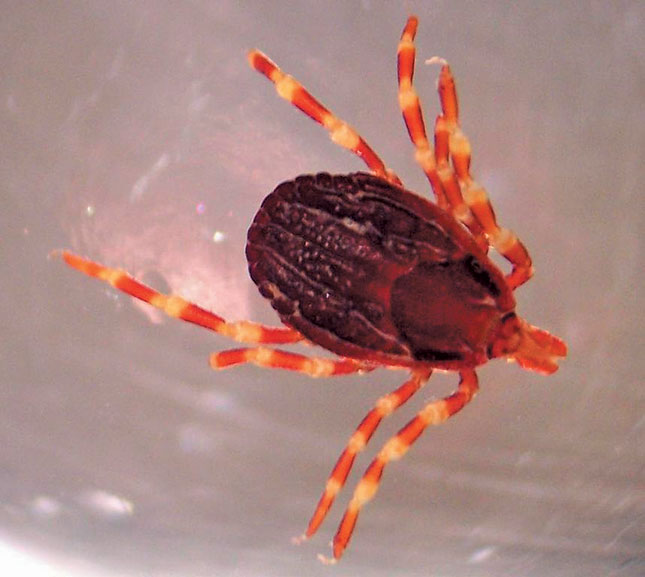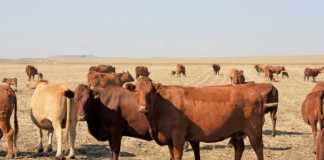
Although only a small number (one to 10) cases of Congo fever are diagnosed in South Africa annually, the disease is extremely serious, with up to 50% of patients dying if they do not receive appropriate medical attention.
Bont-legged ticks (Hyalomma spp.) transmit Crimean-Congo haemorrhagic fever. The virus
can remain in the tick for a long period and even pass through the eggs to infect the next generation.
Immature ticks (larvae and nymphs) feed on small mammals and birds, including guinea fowl. Adult ticks feed on cattle, sheep, goats and ostriches, as well as on antelope.
An animal bitten by an infected tick does not develop the disease, but can circulate the virus in its bloodstream for up to a week. Non-infected ticks become infected by feeding on the animal during this period, spreading the virus further.
A human can become infected if bitten by an infected tick, by squashing it, or if blood from an infected animal comes into contact with broken skin.
On a farm, this usually happens during castration, lamb slaughtering, livestock vaccination, ear notching, or ear tag attachment for identification.
Symptoms
A person usually becomes sick within three days of being bitten by a tick, or five to six days after exposure to the blood of an infected animal or human.
Symptoms include a severe headache with sore, reddened eyes, fever with cold shivers, and intense body pains, particularly involving the muscles of the lower back and thighs.
Nausea and vomiting may occur, sometimes with abdominal pain and diarrhoea during the early stage.
After about five days, the patient may develop a rash of pink blotches on the body. The skin bruises easily, the nose often bleeds and blood may be present in the stool and urine.
The patient may vomit blood and bleed from the gums. A woman may develop severe uterine bleeding. Bleeding from needle puncture sites is common. Internal bleeding can also occur.
The patient goes into a coma from liver, kidney and lung failure. The patient may die, usually from heart failure, five to 14 days after the onset of the illness.
Treatment
Consult a doctor immediately if infection is suspected. Treatment generally consists of intravenous drug treatment and haemodynamic support.
Although evidence is lacking that the virus continues to be excreted in body fluids, a patient should avoid intimate contact with other people for six weeks after recovering from the disease to avoid spreading the infection.
He or she should also avoid heavy manual work or exertion during this time.
Prevention
Anyone likely to be exposed to tick bites should treat clothing, including socks and trousers, with a pyrethroid acaricide. An acaricide is a specific insecticide used against ticks.
Abattoir workers, veterinary staff, farmworkers and hunters should wear impervious protective clothing and gloves when engaged in activities that risk exposure to animal blood.
Although employers must supply protective clothing and safety instructions, employees must take responsibility for complying with these safety regulations.
No human vaccine
At present, there is no human vaccine for Congo fever, and a lack of potential demand for such a vaccine has limited its development.
Source: Swanepoel, B. ‘Crimean-Congo haemorrhagic fever’. DAFF Directorate Communication Services, in co-operation with the National Institute for Virology.













